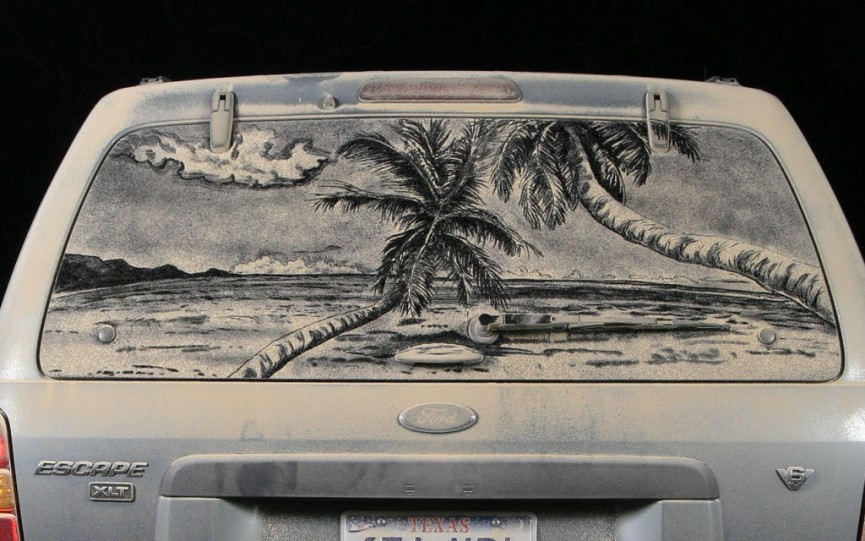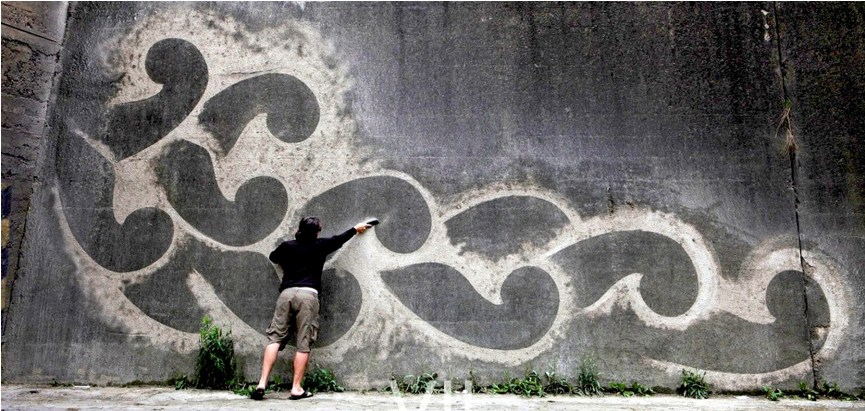Reverse Graffiti - The Art With Clear and Temporary Message
There’s hardly a kid who hasn’t at some point doodled a cheeky wash me onto a dirty car window. We all did it, and often seasoned these messages with simple pictures, replicas of favorite cartoons, flowers, puppies and such. However, none of the kids realized at that point they were actually doing street art, as there was no paint and no real material involved. Reverse graffiti is the generic term for writing by cleaning a layer of dirt off of a surface. The practice is also known as clean tagging, grime writing or green graffiti. The style is perhaps the most environmentally conscious form of street art, as well as the most ephemeral.
How can this be an art movement, someone might ask. The explanation would include facts that reverse graffiti is by definition conducted in public areas, on filthy walls, sometimes even cars; the basic technique of creating an image emulates the Sgraffit0 technique (scratching so as to produce an outline drawing) while artistic tools are in fact - cleaning supplies, water, soap, sponges and pressure cleaners. Final result includes a clear message, an elaborate scene or a design, while the artwork is always temporary, as graffiti inherently is. Still, reverse graffiti was never considered a style until Moose entered the scene, a British artist devoted to environmentalism and a particular visual expression.

Moose
Paul Curtis, a.k.a. Moose is the pioneer of grime writing, having been active on the scene for over 15 years now. Fascinated by the fact of how layered dirt from the urban atmosphere alters coloration of walls and different surfaces, Curtis got the idea to start removing it and orchestrating a suggestive image in the process. Sgraffito technique came as the only logical choice, as it also works by removing the top colored layer in order to reveal a lighter stratum underneath, thus conjuring an image. Although he is considered the official inventor of the reverse graffiti term, he prefers calling it grime writing, as the artistic process implies ‘refacing’, rather than ‘defacing’. In a very classical manner, Moose releases a trapped picture from the stained surface, allowing the fragments of original wall face to shine through the scene. His works are public and ephemeral, as they can be washed off just by cleaning an entire surface. Just before the turn of millennium, he started his own company called Symbollix, offering his painting service to companies in need for this form of guerrilla marketing, in order to give him funds and freedom to pursue his own art.

Orion and Wade
Other known representatives of the small reverse graffiti scene are Alexandre Orion and Scott Wade. The former attracted much of international attention about 8 years ago, when he endeavored to adorn a darkened tunnel in Sao Paulo with grime written set of skulls. His technique was innovative, but the idea was clear - heavy traffic causes pollution and death. The work is known by the name Ossario, due to its macabre thematics. He is not only dedicated to reverse graffiti, but he executes large scale murals and intervenes in urban areas internationally.
Scott Wade, on the other hand, is known for his elaborate designs on car windshields and rear windows. Coming from Texas, he is fascinated with the design opportunities given by a car covered in dirt. Over the years, his style evolved and today he’s creating complex scenes and interpretations of famous paintings, celebrities and other known images. His love for the dirty window as a canvas of choice even drew him to making an ‘artificial’ canvas occasionally, deliberately smudging the glass.
The Environmental Grime Writing
Whatever the written or drawn communique is, the message of reverse graffiti is unequivocally environmental. Moose is very dedicated to this idea, inspired by the surprising and frightening amount of air pollution in London. Atmospheric pollution settles down on walls, buildings, city tunnels, along river banks, leaving a dark residue of fine dust and dirt. The process might be almost invisible to the inhabitants, as it happens over a longer period of time, but when a building is dark grey, things become clear.
This is perhaps the strongest point of reverse graffiti, also called green graffiti. By drawing the attention of people by creating interesting visual solutions, it actually raises awareness about what concerns everybody - escalated pollution and the desire to decrease it. This message is perhaps what differs green graffiti from a traditional spray painting as well, since the latter one is called aerosol, indicating its participation in environmental contamination.

Commercial Use of Reverse Graffiti
Because of its essential harmlessness, numerous companies have recognized the commercial potential within the reverse graffiti. Today, various companies exist across the world, offering guerrilla marketing campaigns realized by the technique, which only employs stencils and pressure cleaners. Therefore, nothing is damaged, and even if some party would have a problem with it - it’s easily removed. The overeager adoption of reverse graffiti by big companies might be the reason behind the fact that the style was never widely accepted. But, there shouldn't be much difference between Nissan hiring Moose to make a wall piece for their electric car campaign, and a commissioned mural.

Wall Cleaning Controversy
Although reverse graffiti is hardly defacing, it’s nontoxic and bears a clearly positive message, the method is still considered vandalism by some. Even Moose was once almost arrested, but as the police couldn't find anything else but cleaning supplies on him, they let him go with a deal to clean what he was doing. The ridiculousness of the situation repeats itself every time this topic is raised, and if any city doesn't want these messages around, they should clean their urban environment. An article about reverse graffiti in Vancouver from the beginning of the year says the west Canadian city considers grime writing vandalism, because graffiti is - graffiti. The rules are rather ambiguous elsewhere, since the technique is so hard to box in, since cleaning a wall obviously cannot be the same as painting it. Yet, as long as the idea is there, perhaps graffiti and its contrast are not so different after all, both rooted in a particular kind of resistance.
Sgraffito is the core of many other street art methods, one of which is developed by Vhils, a Portuguese street artist who removes layers of walls in order to uncover the image beneath. The opposite of guerrilla marketing would be culture jamming.
Do you like art? Stay up to date with a free sign up for My Widewalls!
Can We Help?
Have a question or a technical issue? Want to learn more about our services to art dealers? Let us know and you'll hear from us within the next 24 hours.
